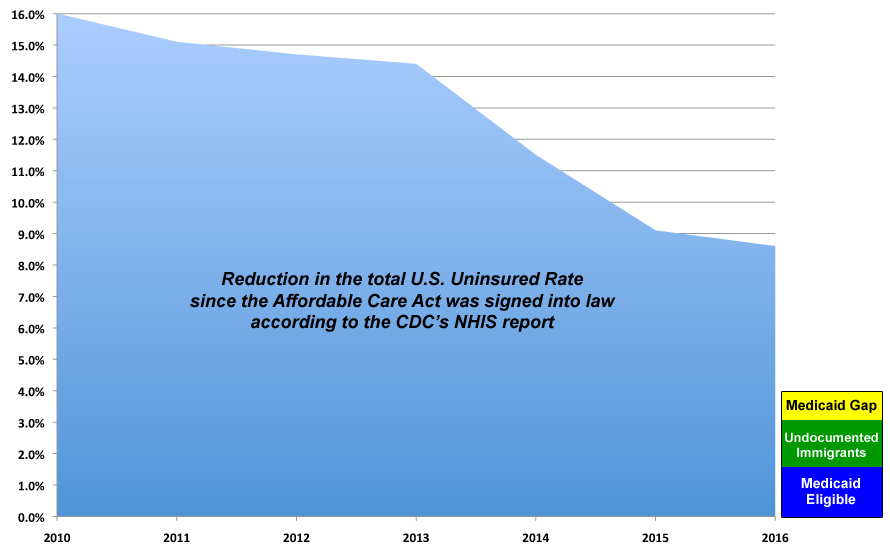Oh, yeah...meanwhile, the uninsured rate has dropped to a historically-low 8.6%.
Given all the ugly ACA-related news over the past month or so (carriers dropping out of markets, average rate hikes going up significantly), it's important to remember the positive impact of the law as well...and today's early release of the latest National Health Interview Survey is very, very good news indeed:
Whenever Gallup releases their quarterly survey re. uninsured rates, I always make sure to note that as accurate as their methods may be in other ways, one major flaw of Gallup's methodology is that they don't include children under 18 whatsoever. This is no small gap, either, since a) children make up about 1/4 of the total population and b) children have historically had a significantly lower uninsured rate than adults (thanks, in no small part, to the Children's Health Insurance Program, spearheaded by Hillary Clinton, I might add). The NHIS, however, includes everyone...and breaks the data out in a whole mess of different ways. Here's what they have to say; note that all data from this survey was as of January - March 2016, so any changes since then (like, say, Louisiana expanding Medicaid to over 278,000 people) is not reflected in it yet):
- In the first 3 months of 2016, 27.3 million (8.6%) persons of all ages were uninsured at the time of interview—1.3 million fewer persons than in 2015 and 21.3 million fewer persons than in 2010.
Yup, the 2016 Open Enrollment Period (along with continuing Medicaid expansion and, to some degree, the ongoing economic recovery) has shaved another 1.3 million off the uninsured tally.
- In the first 3 months of 2016, among adults aged 18–64, 11.9% were uninsured at the time of interview, 19.5% had public coverage, and 70.2% had private health insurance coverage.
- In the first 3 months of 2016, among children aged 0–17 years, 5.0% were uninsured, 42.1% had public coverage, and 54.9% had private coverage.
As I said, Gallup's 11.0% figure from Q2 doesn't include the kids. Add them in and the overall figure drops further.
- Among adults aged 18–64, the 12-month increase in the percentage with private coverage through the Health Insurance Marketplace or state-based exchanges—from 4.4% (8.6 million) in the first quarter of 2015 to 4.7% (9.2 million) in the first quarter of 2016—was not statistically significant.
The total number of people enrolled in effectuated ACA exchange policies increased by 894K people from 3/31/15 - 3/31/16 (10.2M to 11.1M), but in thsi particualr subsample, children aren't included by NHIS, which likely explains most of the missing 294K.
- The percentage of persons under age 65 with private insurance enrolled in a high-deductible health plan (HDHP) increased, from 25.3% in 2010 and 36.7% in 2015 to 40.0% in the first 3 months of 2016.
Ugh. OK, now that's definitely not good news IMHO. I know HDHPs make sense for some people, and it's certainly better than having no coverage whatsoever for others, but let's be honest, no one's happy about having a $5,000+ deductible.
You can read the other data-nerd goodness at the report itself, but I did want to make a couple of points:
- First: Since this data cuts off as of March 2016, it doesn't include Louisiana's ACA Medicaid expansion, which didn't actually go into effect until July 1st (which means it won't show up until the 3rd Quarter survey results). LA's expansion could potentially apply to up to 375K people (it was at 278K the last time I checked), so theoretically, maxing out that number could potentially further reduce the national uninsured rate by another 0.1 percentage points all by itself. However, about 188,000 of them...or 1/2 of the potential maximum...were transferred over from existing state-run healthcare programs, so they may not show up as "newly" insured.
- As I keep noting, even with Louisiana scratched off the list, around 2.8 million of the remaining 27.3 million people are still caught in the Medicaid Gap. You really can't blame the ACA for that; talk to the 19 states which still refuse to expand the program.
- Similarly, around 4.7 million of the remaining uninsured are undocumented immigrants. Again, the ACA specifically prohibits this group from either Medicaid or enrolling in ACA exchange policies (even at full price, which is just silly).
- If you subtract those two groups, you're left with perhaps 20 million people still uninsured which the ACA could even theoretically be accused of "underperforming" with, although that's still quite a stretch.
- Also, according to the Kaiser Family Foundation, up to 5 million of those 20 million are currently eligible for Medicaid after all (either traditional or via expansion) who still haven't actually enrolled in the program. In a sense, this is similar to people who are eligible to vote but fail to actually do so; there's only so much any government program can do to encourage/educate them about it.
NOTE: Yes, I'm aware that the NHIS had the uninsured rate lower than 16% in 1997 (15.4%) and 2005 (14.2%); the only reason I'm not including them below is because there are too many years missing in between. This is just a quick visual to note the trend as well as what the breakout is among nearly half the remaining uninsured:




